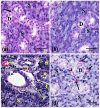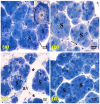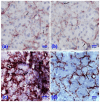Xanthine Oxidase Inhibitor, Febuxostat Is Effective against 5-Fluorouracil-Induced Parotid Salivary Gland Injury in Rats Via Inhibition of Oxidative Stress, Inflammation and Targeting TRPC1/CHOP Signalling Pathway
- PMID: 35215344
- PMCID: PMC8880727
- DOI: 10.3390/ph15020232
Xanthine Oxidase Inhibitor, Febuxostat Is Effective against 5-Fluorouracil-Induced Parotid Salivary Gland Injury in Rats Via Inhibition of Oxidative Stress, Inflammation and Targeting TRPC1/CHOP Signalling Pathway
Abstract
The current research aimed to examine the ameliorative role of febuxostat (FEB), a highly potent xanthine oxidase inhibitor, against 5-fluorouracil (5-FU)-induced parotid salivary gland damage in rats, as FEB is a pleiotropic drug that has multiple pharmacological effects. A total of 32 Wistar adult male rats were randomly arranged into four groups. Group 1: the control group; given only the vehicle for 14 days, then given a saline i.p. injection from the 10th to the 14th day. Group 2: the FEB group; rats received FEB (10 mg/kg) once daily po for 14 days before receiving a saline i.p. injection from the 10th to the 14th day. Group 3: the 5-FU group; from the 10th to the 14th day, rats received an intraperitoneal injection of 5-FU (35 mg/kg/day). Group 4: the FEB/5-FU group; rats were pre-treated with FEB po for 14 days before receiving 5-FU i.p injections for five consecutive days from the 10th to the 14th day. Parotid gland damage was detected histologically and biochemically by the evaluation of oxidative stress markers (malondialdehyde (MDA) and nitric oxide levels (NOx)), oxidant defences (reduced glutathione (GSH) and superoxide dismutase (SOD)), inflammatory markers (tumour necrosis factor-alpha (TNF-α), interleukin-1β (IL-1β)), and transient receptor potential canonical1 (TRCP1) and C/EBP homologous protein (CHOP). FEB pre-treatment reduced MDA, TNF-, and IL-1 while increasing SOD, GSH, and NOx. FEB also significantly increased TRPC1 and decreased CHOP in parotid gland tissue. In conclusion, FEB pre-treatment reduced 5-FU-induced parotid salivary gland damage not only through its powerful anti-inflammatory and antioxidant effects, but also through its effect on the TRPC1/CHOP signalling pathway.
Keywords: CHOP; TRPC1; febuxostat; fluorouracil; parotid damage.
Conflict of interest statement
The authors declare no conflict of interest.
Figures





Similar articles
-
Diacerein modulates TLR4/ NF-κB/IL-1β and TRPC1/CHOP signalling pathways in gentamicin-induced parotid toxicity in rats.J Cell Mol Med. 2023 Jun;27(12):1735-1744. doi: 10.1111/jcmm.17791. Epub 2023 May 31. J Cell Mol Med. 2023. PMID: 37257043 Free PMC article.
-
Protective effect of febuxostat in sepsis-induced liver and kidney injuries after cecal ligation and puncture with the impact of xanthine oxidase, interleukin 1β, and c-Jun N-terminal kinases.Hum Exp Toxicol. 2020 Jul;39(7):906-919. doi: 10.1177/0960327120905957. Epub 2020 Feb 13. Hum Exp Toxicol. 2020. PMID: 32054342
-
Role of EGF/ERK1/2/HO-1 axis in mediating methotrexate induced testicular damage in rats and the ameliorative effect of xanthine oxidase inhibitors.Immunopharmacol Immunotoxicol. 2023 Oct;45(5):511-520. doi: 10.1080/08923973.2023.2181684. Epub 2023 Mar 8. Immunopharmacol Immunotoxicol. 2023. PMID: 36883686
-
5-Fluorouracil induces inflammation and oxidative stress in the major salivary glands affecting salivary flow and saliva composition.Biochem Pharmacol. 2017 Dec 1;145:34-45. doi: 10.1016/j.bcp.2017.08.024. Epub 2017 Sep 1. Biochem Pharmacol. 2017. PMID: 28867645
-
Febuxostat treatment attenuates oxidative stress and inflammation due to ischemia-reperfusion injury through the necrotic pathway in skin flap of animal model.Free Radic Biol Med. 2021 Dec;177:238-246. doi: 10.1016/j.freeradbiomed.2021.10.033. Epub 2021 Oct 29. Free Radic Biol Med. 2021. PMID: 34737143
Cited by
-
Pregnancy and COVID-19: high or low risk of vertical transmission.Clin Exp Med. 2023 Aug;23(4):957-967. doi: 10.1007/s10238-022-00907-z. Epub 2022 Oct 17. Clin Exp Med. 2023. PMID: 36251144 Free PMC article.
-
Diacerein modulates TLR4/ NF-κB/IL-1β and TRPC1/CHOP signalling pathways in gentamicin-induced parotid toxicity in rats.J Cell Mol Med. 2023 Jun;27(12):1735-1744. doi: 10.1111/jcmm.17791. Epub 2023 May 31. J Cell Mol Med. 2023. PMID: 37257043 Free PMC article.
-
Facilitating Nitrite-Derived S-Nitrosothiol Formation in the Upper Gastrointestinal Tract in the Therapy of Cardiovascular Diseases.Antioxidants (Basel). 2024 Jun 4;13(6):691. doi: 10.3390/antiox13060691. Antioxidants (Basel). 2024. PMID: 38929130 Free PMC article. Review.
-
The Protective Effects of MSC-Derived Exosomes Against Chemotherapy-Induced Parotid Gland Cytotoxicity.Int J Dent. 2025 Apr 3;2025:5517092. doi: 10.1155/ijod/5517092. eCollection 2025. Int J Dent. 2025. PMID: 40223864 Free PMC article.
-
Immune and non-immune mediators in the fibrosis pathogenesis of salivary gland in Sjögren's syndrome.Front Immunol. 2024 Oct 14;15:1421436. doi: 10.3389/fimmu.2024.1421436. eCollection 2024. Front Immunol. 2024. PMID: 39469708 Free PMC article. Review.
References
-
- Bachmeier E., López M.M., Linares J.A., Brunotto M.N., Mazzeo M.A. 5-Fluorouracil and Cyclophosphamide modify functional activity in submandibular gland of rats. J. Oral Res. 2019;8:363–369.
-
- Elmansy M.N., Hegazy E.M. Evaluation of the Apoptotic changes induced by 5-Fluorouracil on the Lingual Mucosa and Salivary glands of male albino rats (Histological, Histomorphometric and Immunohistochemical Study) Egypt. Dent. J. 2020;66:2353–2363. doi: 10.21608/edj.2020.41503.1240. - DOI
LinkOut - more resources
Full Text Sources
Research Materials

